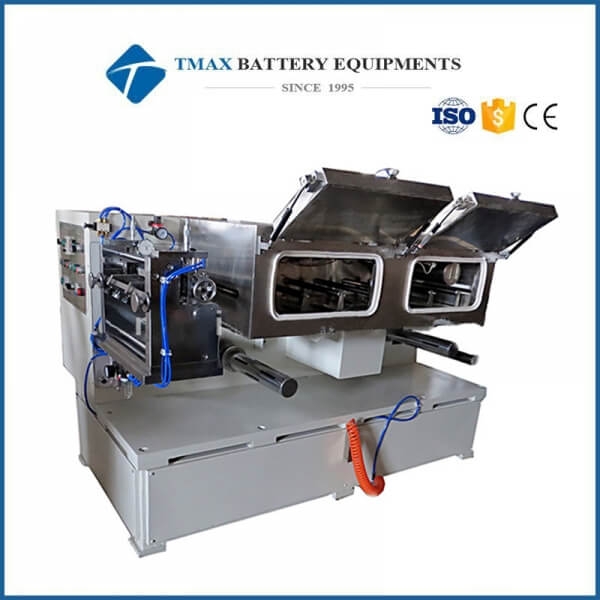مدونة الموقع
اتصل بنا
- إذا كانت لديك أسئلة، يرجى الاتصال بنا، وسيتم الرد على جميع الأسئلة
- البريد الإلكتروني : David@tmaxcn.com
- البريد الإلكتروني : Davidtmaxcn@gmail.com
- إضافة : No. 39, Xinchang Road, Xinyang, Haicang Dist., Xiamen, Fujian, China (Mainland)
المنتجات الساخنة
Xiamen Tmax Battery Equipments Limited was set up as a manufacturer in 1995, dealing with lithium battery equipments, technology, etc. We have total manufacturing facilities of around 200000 square foot and more than 230 staff. Owning a group of experie-nced engineers and staffs, we can bring you not only reliable products and technology, but also excellent services and real value you will expect and enjoy.
Dry Electrode Film Laminating Machine: A Critical Tool in Advanced Battery Manufacturing
The dry electrode film laminating machine is a specialized piece of equipment used in the production of dry electrodes for energy storage devices, such as lithiumion batteries and solidstate batteries. This machine plays a crucial role in bonding the dry powder mixture (comprising active materials, binders, and conductive additives) to a current collector foil (e.g., aluminum or copper). By using heat, pressure, and sometimes adhesive layers, the laminating machine ensures strong adhesion between the electrode material and the foil, creating a durable and uniform electrode layer.
Unlike traditional wetcoating methods that rely on solventbased slurries, the dry electrode film laminating machine eliminates the need for solvents, significantly reducing environmental impact while enhancing the mechanical properties of the electrode.
●What Is a Dry Electrode Film Laminating Machine?
A dry electrode film laminating machine is a highprecision device designed to bond a dry electrode film onto a current collector foil. It uses heat, pressure, or other bonding techniques to create a strong and uniform connection between the electrode material and the foil. The result is a highly compacted electrode layer with excellent adhesion, mechanical stability, and electrical conductivity.
The primary goal of the dry electrode film laminating machine is to enable sustainable, efficient, and highperformance electrode fabrication for advanced energy storage applications.
●Key Components of a Dry Electrode Film Laminating Machine
A typical dry electrode film laminating machine consists of the following key components:
1. Lamination Rollers
Consists of two or more rollers that apply controlled heat and pressure to bond the dry electrode film to the current collector foil.
Ensures uniform thickness and density of the electrode layer.
2. Temperature Control System
Maintains consistent temperatures during the lamination process to optimize bonding without damaging the materials.
Some machines may incorporate heating or cooling mechanisms to finetune the bonding process.
3. Pressure Control System
Adjusts the pressure applied by the rollers to achieve optimal bonding strength without causing defects.
Provides precise control over the mechanical properties of the electrode.
4. Feeding System
Supplies the dry electrode film and current collector foil to the laminating rollers in a continuous and controlled manner.
Ensures proper alignment and tension of the foil for accurate bonding.
5. Alignment System
Ensures precise alignment between the dry electrode film and the current collector foil to prevent misalignment or uneven bonding.
6. Quality Inspection System
Monitors the bonding quality in realtime to ensure uniformity and detect defects such as air pockets, delamination, or cracks.
Alerts operators if deviations occur, allowing for immediate adjustments.
7. Waste Collection System
Captures excess material or debris generated during the lamination process.
Reduces material waste and ensures a clean working environment.
●Processes Performed by a Dry Electrode Film Laminating Machine
The dry electrode film laminating machine performs the following key processes:
1. Feeding: The dry electrode film and current collector foil are fed into the machine.
2. Bonding: The laminating rollers apply controlled heat and pressure to bond the electrode film to the foil.
3. Monitoring: Realtime measurements ensure the electrode layer meets specifications for thickness, density, and uniformity.
4. Collection: The laminated foil is collected for further processing, such as cutting and tab welding.
●Advantages of a Dry Electrode Film Laminating Machine
1. Environmental Benefits:
Eliminates the use of toxic solvents, reducing emissions and waste.
Reduces energy consumption by avoiding drying and solvent recovery processes.
2. Improved Performance:
Produces electrodes with higher density and better mechanical stability, leading to improved cycle life and performance.
Allows for higher loading of active materials, increasing energy density.
3. Cost Savings:
Simplifies the production process by eliminating solventrelated steps.
Reduces material waste due to precise handling and realtime quality checks.
4. Scalability:
Enables faster production rates compared to traditional wetcoating methods.
Can be easily scaled up for mass production.
5. Flexibility:
Compatible with a wide range of materials, including nextgeneration chemistries like silicon anodes and solidstate electrolytes.
6. Safety:
Minimizes exposure to hazardous chemicals, improving workplace safety.
●Challenges in a Dry Electrode Film Laminating Machine
Despite its advantages, the dry electrode film laminating machine faces certain challenges:
1. Uniformity Control:
Achieving consistent bonding strength and thickness across large areas can be challenging due to variations in material properties or roller wear.
2. Material Handling:
Proper feeding and alignment of the dry electrode film and current collector foil require precise control to avoid defects.
3. High Initial Costs:
Advanced machinery and specialized components come with significant upfront investment.
4. Binder Selection:
Developing binders that work effectively in dry conditions while maintaining adhesion and flexibility is complex.
5. Process Optimization:
Finetuning parameters such as temperature, pressure, and speed is essential for achieving consistent results at scale.
●Innovations in Dry Electrode Film Laminating Machines
To address these challenges and enhance productivity, manufacturers are incorporating cuttingedge technologies:
1. Advanced Roller Designs:
Precisionengineered rollers with optimized surface textures improve bonding and adhesion.
2. AI and Machine Learning:
Predictive analytics optimize machine performance, detect anomalies, and improve yield rates.
3. RealTime Monitoring Systems:
Integrated sensors and vision systems provide continuous feedback on bonding quality, thickness, and uniformity.
4. Modular Design:
Flexible systems allow for easy reconfiguration to test new materials and chemistries.
5. Sustainability Features:
Ecofriendly practices minimize waste and energy consumption during the fabrication process.
6. Integration with Automation:
Collaborative robotics and IoTenabled systems enhance efficiency and reduce human intervention.
●Applications of Dry Electrode Film Laminating Machines
Dry electrode film laminating machines are used in various industries, including:
1. Battery Production:
Produces electrodes for lithiumion batteries, solidstate batteries, and other advanced battery chemistries.
2. Supercapacitors:
Creates highperformance electrodes for energy storage applications in consumer electronics, automotive systems, and renewable energy.
3. Automotive Industry:
Manufactures electrodes for electric vehicle (EV) batteries, focusing on improving energy density and reducing costs.
4. Renewable Energy:
Develops durable electrodes for gridscale energy storage systems.
5. Consumer Electronics:
Produces compact and efficient electrodes for smartphones, wearables, and portable devices.
●The Future of Dry Electrode Film Laminating Machines
As the demand for sustainable and highperformance energy storage solutions grows, dry electrode film laminating machines will continue to evolve. Key trends shaping the future include:
1. Increased Automation:
Fully autonomous systems will further boost production speeds and reduce costs.
2. Customization Options:
Modular designs will enable manufacturers to tailor machines for specific materials and cell designs.
3. Focus on Sustainability:
Ecofriendly practices and recycling capabilities will become integral parts of future machines.
4. Integration with Emerging Technologies:
Solidstate batteries, flexible electronics, and autonomous systems will drive new innovations in machine design.
5. Smart Manufacturing:
IoTenabled machines will leverage big data and AI to optimize production, reduce waste, and enhance efficiency.
●Conclusion
The dry electrode film laminating machine is a cornerstone of modern energy storage manufacturing, enabling sustainable, efficient, and highperformance electrode fabrication. Its ability to eliminate solvents, reduce waste, and improve mechanical properties makes it a gamechanger for battery and supercapacitor production.
What excites you most about the role of dry electrode film laminating machines in driving innovation and sustainability in the energy storage sector? Share your thoughts below! Together, let’s explore how this technology can shape the future of energy storage.
 ru
ru English
English











 Iris@tmaxcn.com
Iris@tmaxcn.com David@tmaxcn.com
David@tmaxcn.com +86 13174506016
+86 13174506016
